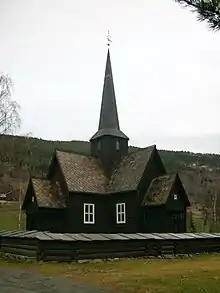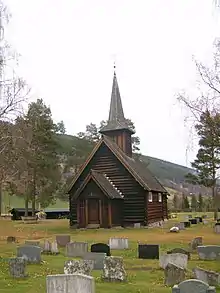Heidal Church
Heidal Church (Norwegian: Heidal kirke) is a church in Heidal, a side valley of the Gudbrand Valley, in the municipality of Sel in Innlandet county, Norway.[1][2]
| Heidal Church | |
|---|---|
Heidal kirke | |
 | |
 Heidal Church Location in Innlandet  Heidal Church Heidal Church (Norway) | |
| Location | Heidal |
| Country | Norway |
| Denomination | Church of Norway |
| Churchmanship | Evangelical Lutheran |
| History | |
| Status | Parish church |
| Architecture | |
| Functional status | Active |
| Completed | 1941 |
| Specifications | |
| Capacity | 292[1] |
| Materials | Wood |
| Administration | |
| Deanery | Nord-Gudbrandsdal |
The church was built from 1937 to 1941[1] and is a copy of an older church that burned down in 1933[3][4] due to a lightning strike.[2] Heidal Church is a timbered wood church; it is a cruciform church like most of the churches in the Gudbrand Valley. It is able to accommodate 292 people.[1] The church has three galleries, and the organ is located in the gallery over the entrance. The other two galleries are outfitted with benches.
The church is richly decorated, largely consisting of carved acanthus elements. The woodcarvings in Heidal Church were created by three local woodcarvers—Mattias Fjerdingren, Anders Johnsgard, and Paul Sørhaugen[2]—and Edvard Bakkom from Vågå created the sculptures. The main image on the altarpiece shows Christ crucified. To the side of the cross stand Jesus's mother Mary and the disciple John. This central image is flanked by Moses holding the Tables of the Law and Aaron clothed as a high priest. At the top of the altarpiece, Christ is depicted holding a victory banner. This banner in Heidal Church is painted with a white cross on a red background instead of a red cross on a white background, as is customary. This creates the impression that the resurrected Christ is holding a Danish banner.
The pulpit is covered with carvings, as are the end pieces on all the pews. The ceiling painting under the church's tower shows the Four Evangelists: Matthew, Mark, Luke, and John. The Eye of Providence is painted above the chancel. Two cherubs blowing horns are painted above the organ.
The church, its cemetery, and the Bjølstad Chapel are encircled by a sturdy double-layered timber-framed roofed wall.
Bjølstad Chapel

The old Bjølstad Church (Bjølstad kirke), usually referred to as the Bjølstad Chapel (Bjølstad kapell), stands next to Heidal Church. As the name indicates, it formerly stood at the Bjølstad Farm, a few kilometers north of the church site in Heidal. The oldest sources connect it with the Christianization of Norway. The first church in Heidal was a small stave church at the Nordre Parsonage, believed to have been built between 1000 and 1050. The discovery of gravestones and remains there also indicates that there was a cemetery at the site.
In the 1500s the parsonage church was relocated to the Bjølstad Farm.[2][3] Eventually the church became too small, and a new church was erected at Bjølstad. It was a timber-framed church that also used material from the old church. The most visible remnants today from the earliest church are the old doorposts, which date back to the 1000s. These doorposts are decorated with Norway's oldest carvings. When the new church in Heidal, known as Tabor Church,[2] was built in 1754, Bjølstad Church became redundant and was no longer used.[3] For a time it was used as a barn, and then it was dismantled and put into storage.[2]
The church was first reassembled in 1962 at a new location, next to the new Heidal Church. In addition to the doorposts, it preserves other old elements: the pulpit, a crucifix, the tower, and the bell. Its altar, which was painted by Borgar Hauglid at the time that the church was reassembled in 1962, depicts the resurrected Christ with the banner of victory. The decoration of the church's interior is otherwise modest. The Bjølstad Chapel is able to accommodate 120 people and it is used for scheduled worship services only a few times a year.
References
- "Follebu kirke". Kirkesøk. Retrieved November 7, 2017.
- "Heidal kirke og Bjølstad kapell". Norsk kirkebygg. Retrieved November 7, 2017.
- Grieg, Sigurd. Gudbrandsdalen i mellomalderen: Kristningsverket. Hamar: Norsk Skoletidendes Boktrykkeri. p. 246.
- Den Norske turistforenings årbok. Oslo: Grøndahl & Søns Boktrykkeri. 1976. p. 89.